The Basics of Subcontractor Defaults – Key Considerations
February 15, 2021 —
Gerard J. Onorata - Peckar & Abramson, P.C.The success of general contractors in completing a construction project is often dependent upon the performance of their subcontractors. General contractors have frequently said exactly this. Traditionally, the key subcontractors on a project are the electrical, plumbing, HVAC and structural steel subs. Due to the fundamental nature of the work performed by these trades, the risk of defaulting and terminating one or more of them is likely to have a substantial impact on the project, more so than with the trade contractors that perform their work after a building is made weather tight (i.e., drywall, tile, painting).
Most general contractors have, over a period of years, established longstanding relationships with certain subcontractors that they have come to depend upon. The risk of having to default and terminate one of these subs is minimal. Nevertheless, there will inevitably arise occasions when even a once reliable subcontractor fails to perform and it becomes necessary to invoke the remedies of default and termination. Areas ripe for controversy with subcontractors that often can lead to default and termination often involve disputes over change orders and the scope of work, the installation of defective work and the back-charges that ensue therefrom, and, to a lesser extent, conflicts that arise from ambiguous plans and specifications and the extra work and delays caused by the discovery of unforeseen site conditions.
Read the court decisionRead the full story...Reprinted courtesy of
Gerard J. Onorata, Peckar & Abramson, P.C.Mr. Onorata may be contacted at
gonorata@pecklaw.com
Google Advances Green Goal With AES Deal for Carbon-Free Power
May 17, 2021 —
Mark Chediak - BloombergGoogle’s moving forward with its goal of becoming carbon-free by the end of the decade after AES Corp. agreed to supply the tech giant with renewable energy to power its data centers in Virginia.
AES, an international electricity company and power-plant developer, said the deal will result in the construction of 500 megawatts of solar, wind, small-scale hydroelectric and battery storage projects and supply will begin later this year, according to a statement Tuesday. AES and third-party developers will own the facilities.
Read the court decisionRead the full story...Reprinted courtesy of
Mark Chediak, Bloomberg
Mediation v. Arbitration, Both Private Dispute Resolution but Very Different Sorts
January 24, 2018 —
Christopher G. Hill - Construction Law MusingsI often get calls from clients, potential construction clients, and other construction and business professionals with questions about arbitration or
mediation clauses in the contracts that they are reviewing or drafting. When I get these calls, it often becomes clear that, understandably, there is some confusion as to what each of these alternate dispute resolution processes entails. I thought I’d put together a quick primer on what each is and their differences.
Read the court decisionRead the full story...Reprinted courtesy of
Christopher G. Hill, The Law Office of Christopher G. HillMr. Hill may be contacted at
chrisghill@constructionlawva.com
Delaware State Court Holds that Defective Workmanship Claims do not Trigger Coverage by a Builder’s Commercial General Liability Policy
April 15, 2015 —
Marc S. Casarino – White and Williams LLPGuided by federal case law, on March 31, 2015 a Delaware state court held for the first time in Westfield Ins. Co. v. Miranda & Hardt Contracting and Building Services LLC that a builder’s poor workmanship is not an occurrence for which the builder’s insurance policy affords coverage. In the underlying case giving rise to the coverage dispute, a homeowner alleged that a builder deviated from approved building plans, used inadequate materials, improperly installed materials, violated building codes, and fraudulently represented that a home was properly constructed. The homeowner sued the builder under theories of negligence, negligence per se, and fraud. The insurer denied the builder’s request for defense and indemnification for the homeowner’s claims, citing in part that the allegations of defective workmanship did not qualify as an “occurrence” as defined by the builder’s insurance policy.
The builder did not dispute that the underlying complaint alleged defective workmanship. However, the builder asserted that because it had not yet been proven that its work was defective, the insurer had prematurely denied coverage. The court properly rejected the builder’s argument, and reiterated that under Delaware law the court must compare the allegations of the complaint to the insurance policy terms to make a coverage determination. Whether the complaint’s allegations are ultimately meritorious is irrelevant to the initial coverage determination according to the court.
Read the court decisionRead the full story...Reprinted courtesy of
Marc S. Casarino, White and Williams LLPMr. Casarino may be contacted at
casarinom@whiteandwilliams.com
No Coverage For Damage Caused by Chinese Drywall
December 02, 2015 —
Tred R. Eyerly – Insurance Law HawaiiThe Florida Court of Appeals determined that there was no coverage for damage to the insured's home caused by the installation of Chinese drywall. Peek v. Am. Integrity Ins. Co., 2015 Fla. App. LEXIS 14147 (Fla. Ct. App. Sept. 25, 2015).
Chinese drywall was installed in the Peek's new home. After moving in, the Peeks reported to American Integrity a sulfur odor caused by the Chinese drywall. The odor caused the Peeks to vacate their home. The Peeks also claimed corrosion and deterioration of copper coils in the air conditioning system were caused by the Chinese drywall.
American Integrity denied coverage based upon policy exclusions for latent defects, corrosion, pollutants, and faulty, inadequate or defective constrution materials. The Peeks sued American Integrity.
Read the court decisionRead the full story...Reprinted courtesy of
Tred R. Eyerly, Insurance Law HawaiiMr. Eyerly may be contacted at
te@hawaiilawyer.com
Arizona Purchaser Dwelling Actions Are Subject to a New Construction
September 04, 2019 —
William L. Doerler - The Subrogation StrategistArizona recently amended its Purchaser Dwelling Action statute to, among other things, involve all contractors in the process, establish the parties’ burdens of proof, add an attorney fees provision, establish procedural requirements and limit a subcontractor’s indemnity exposure. The governor signed the bill—2019 Ariz. SB 1271—on April 10, 2019, and the changes go into effect and apply, retroactively “to from and after June 30, 2019.” The following discussion details some of the changes to the law.
Notice to Contractors and Proportional Liability
Under the revised law, a “Seller” who receives notice of a Purchaser Dwelling Action (PDA) from a residential dwelling purchaser pursuant to A.R.S. § 12-1363* has to promptly forward the notice to all construction professionals—i.e. architects, contractors, subcontractors, etc., as defined in A.R.S. § 12-1361(5)—that the Seller reasonably believes are responsible for an alleged construction defect. A.R.S. § 12-1363(A). Sellers can deliver the notice by electronic means. Once construction professionals are placed on notice, they have the same right to inspect, test and repair the property as the Seller originally placed on notice. A.R.S. § 12-1362(B), (C).
To the extent that the matter ultimately goes to suit, A.R.S. § 12-1632(D) dictates that, subject to Arizona Rules of Court, construction professionals “shall be joined as third-party defendants.” To establish liability, the purchaser has the burden of proving the existence of a construction defect and the amount of damages. Thereafter, the trier of fact determines each defendant’s or third-party defendant’s relative degree of fault and allocates the pro rata share of liability to each based on their relative degree of fault. However, the seller, not the purchaser, has the burden of proving the pro rata share of liability for any third-party defendant. A.R.S. § 12-1632(D).
Read the court decisionRead the full story...Reprinted courtesy of
William L. Doerler, White and Williams LLPMr. Doerler may be contacted at
doerlerw@whiteandwilliams.com
2011 Worst Year Ever for Home Sales
September 09, 2011 —
CDJ STAFFSo few new single-family homes have sold in 2011 that expectations are that this will be the worst year for new homes sales since the Commerce Department started tracking this in 1963. The Harford Courant notes that previously builders created a new supply to which was added homes under foreclosure.
Ed Leamer, economist and director of UCLA’s Anderson Forecast, says that recovery would be driven by two sectors, manufacturing and construction. “It doesn’t look like there is going to be a big recovery in manufacturing,” he says. “It is going to have to come in housing.”
The soft housing market, however, is leading to a loss of construction jobs, as reported by the Associated General Contractors of America. As a result, stock prices for the twelve largest publicly-traded home builders have declined 22.7 percent in a market that has declined 4.2 percent overall.
Read the full story…
Read the court decisionRead the full story...Reprinted courtesy of
20 Years of BHA at West Coast Casualty's CD Seminar: Chronicling BHA's Innovative Exhibits
May 03, 2018 —
Beverley BevenFlorez-CDJ STAFFThe Bert L. Howe & Associates, Inc., (BHA) exhibit has been a fixture at West Coast Casualty's Construction Defect Seminar since the mid-1990's. Through the years, BHA has updated their display, but no matter what year, you could count on the BHA exhibit to provide a not-to-be-missed experience.
2008-BHA's sleek, rear projection display includes a screen that promotes the firm's capabilities that can be seen throughout the exhibit hall. This would be one of many innovations BHA has brought to the West Coast Casualty seminar.
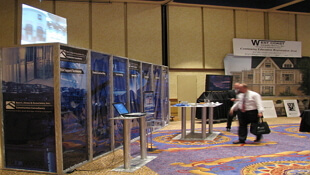
2009-With the success of the rear screen projection, BHA adds additional monitors to provide attendees with more information about BHA.
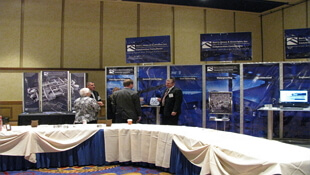
2010-BHA adds an interpretive professional development exhibit targeted to Building Envelope issues allowing adjusters and other non-construction professionals hands on access to the systems and components at the heart of many related such claims.


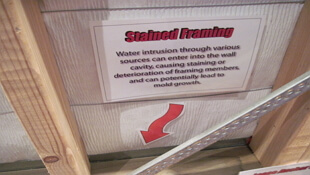
2011-BHA's Swing for Charity challenge is born.

2012-Always innovating, BHA expands its rear projection and professional development offerings to West Coast attendees.

2013-BHA showcases additional capabilities with a twenty-four foot, custom, convex, immersive video experience.

2014-BHA adds an iPhone display to give a hands-on demonstration of their data collection methods.
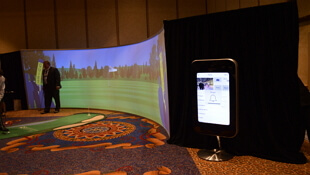
2015-BHA's twenty-four foot , custom, convex, immersive video experience was elevated with two additional rear projection screens, reflecting BHA's newest capabilities and services.

2016-BHA dazzles attendees with their new exhibit comprised of more than 15 integrated, high definition, LCD displays. iPads are stationed on tables to conveniently demonstrate BHA's data collection processes.
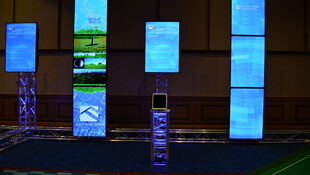
2017-BHA's Swing for Charity Golf Challenge raised $2,225.00 for the National Coalition for Homeless Veterans and $1,900 for Final Salute.
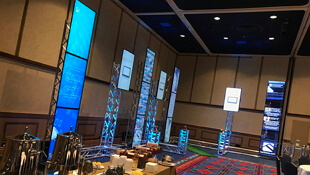
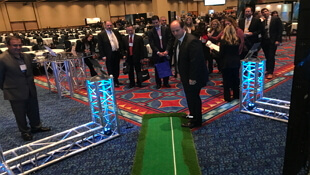
Read the court decisionRead the full story...Reprinted courtesy of




































































